Welcome to the time worksheets page at Math-Drills.com where taking your time is encouraged! On this page you will find Time math worksheets including elapsed time, telling time on analog clocks, calendars and converting time worksheets.
The calendars come in two different formats: yearly (all on one page) and monthly when you need extra space or a larger layout. The calendars are very useful in conjunction with the elapsed time worksheets with days, weeks, months, and years. Students who have difficulty visualizing a calendar may need the actual calendars to use as a reference. Telling time on analog clocks is still an important skill despite the number of digital clocks around; many people still choose the analog clock design for aesthetic purposes.
Most Popular Time and Clock Worksheets this Week



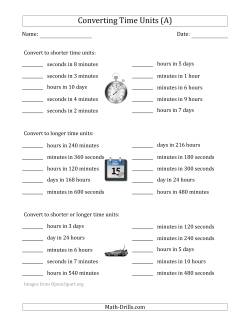
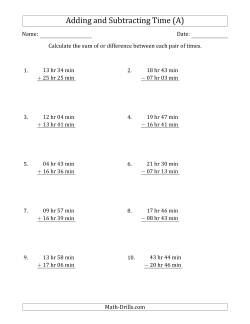
Calendars

The calendars on this page are meant for anyone to use for purposes including personal schedules, classroom planning, holiday calendars, business meetings, event calendars, or anything else. They can also be used in math activities such as elapsed date activities. A simple activity with the monthly calendars is to ask students to place an item or mark on specific spots on the calendar (e.g. "Place a bean on a Tuesday in March."). After students become familiar with how a calendar is laid out and works, you can create more challenging activities like finding elapsed dates, discovering the number of days in each month, scheduling activities, etc.
Yearly calendars are a great way to see an entire year on one page. Although not easy to write on all your appointments and anniversaries, they are a quick reference and can be very useful when completing math activities to familiarize students with calendars or more advanced activities with calendars.
Specific yearly calendars for the years 2000 to 2050 are available in this section. For any other year or if you want a custom title, you can use the general yearly calendars with fillable titles. There are seven general yearly calendars and seven general leap year calendars in two different formats (Sunday to Saturday and Monday to Sunday) which will cover any year from 1583 on.
A great number of math activities can be accomplished with monthly calendars. Familiarization activities include finding specific dates, determining which day of the week it is, marking important events on the calendar, and determining the number of days in each month, week or year. Further activities mainly include elapsed date activities where students find the number of days, weeks and/or months between two dates or find a date a certain number of months, weeks and/or days in the future or the past. Of course, these calendars can also be used as normal reference calendars by anyone.
Originally, Math-Drills calendars always started on Sundays, but there are many people in the world who use calendars starting on Mondays. A good argument can be made by thinking of the word, "weekend." The end of the week or week end is Saturday and Sunday, so why would you put Sunday at the beginning of the week? Luckily, both options exist, so pick the one that suits you the best.
Fillable means that you can type whatever you like into each date. It is possible to add up to seven short lines of text. This is useful if you want to write important dates onto the calendar or create activities for students (e.g. what date is 78 days from today?).
Reading and Sketching Time on Analog Clocks
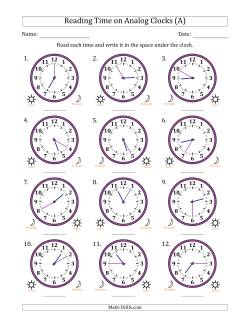
Even though the time is displayed digitally in so many places these days—on cell phones, on computers, on microwaves—there are still quite a few analog clocks around. Besides being able to tell time on an analog clock, this is probably one of the first places that students encounter a number system other than base ten. Thanks to the Babylonians et. al. we have 60 seconds in a minute and 60 minutes in an hour. Once your students master the intricacies of the time system, they can start learning about other useful number systems like hexadecimal and binary, both of which are heavily used in computer programming.
Suns and moons are included with each clock to indicate the time of day. Think of the moon as midnight and the sun as noon. If the clock has a moon (midnight) on the left and a sun (noon) on the right, then the time is between midnight and noon (AM in North America). The reverse means that the time is between noon and midnight (PM in North America).
These clock worksheets include hour and minute hands, so students who are starting to learn reading time on analog clocks only have to worry about two arms. There are a variety of intervals available depending on the level of the student. The goal is to get students to be able to tell time to the minute. There are versions with twelve clocks and versions with four large clocks.
-
Reading 12 Hour Time in One Hour Intervals (4 Large Clocks) Reading 12 Hour Time in 30 Minute Intervals (4 Large Clocks) Reading 12 Hour Time in 15 Minute Intervals (4 Large Clocks) Reading 12 Hour Time in 5 Minute Intervals (4 Large Clocks) Reading 12 Hour Time in 1 Minute Intervals (4 Large Clocks)
These worksheets also include second hands in various intervals. These are best to use after students have mastered reading time to the minute. The addition of a third hand challenges them more and helps them understand how many seconds are in a minute.
Students encounter 24 hour time in various places such as on plane tickets, in computer programming and in literature. These worksheets are similar to reading 12 hour clocks, but include a second set of numbers on the inside of the minute ticks.
-
Reading 24 Hour Time in One Hour Intervals (4 Large Clocks) Reading 24 Hour Time in 30 Minute Intervals (4 Large Clocks) Reading 24 Hour Time in 15 Minute Intervals (4 Large Clocks) Reading 24 Hour Time in 5 Minute Intervals (4 Large Clocks) Reading 24 Hour Time in 1 Minute Intervals (4 Large Clocks)
These 24 hour clocks also include second hands, so students can read time represented on clocks to the nearest second.
Once students are able to read time off of analog clocks, they can be challenged to sketch time. This might seem easy, but analog clocks tend to have a small quirk in that the hands don't always point to the exact number. For example, if it is 6:30, the hour hand will be half way between the 6 and the 7. Taking time to point this out to students will ensure they succeed on these worksheets.
-
Sketching 12 Hour Time in One Hour Intervals (4 Large Clocks) Sketching 12 Hour Time in 30 Minute Intervals (4 Large Clocks) Sketching 12 Hour Time in 15 Minute Intervals (4 Large Clocks) Sketching 12 Hour Time in 5 Minute Intervals (4 Large Clocks) Sketching 12 Hour Time in 1 Minute Intervals (4 Large Clocks)
Once students have mastered sketching in the hour and minute hands, it is time to add the second hands. As with the hour hand, the minute hand doesn't always point exactly to the minute. For example, if it is 6:30:45, the minute hand will be about 3/4 of the way to the :31 mark. If they have learned this about the hour hand already, it shouldn't be too much of a leap to get them to understand this about the minute hand.
Very much the same as sketching on 12 hour clocks, these worksheets use 24 hour time.
-
Sketching 24 Hour Time in One Hour Intervals (4 Large Clocks) Sketching 24 Hour Time in 30 Minute Intervals (4 Large Clocks) Sketching 24 Hour Time in 15 Minute Intervals (4 Large Clocks) Sketching 24 Hour Time in 5 Minute Intervals (4 Large Clocks) Sketching 24 Hour Time in 1 Minute Intervals (4 Large Clocks)
Converting Time
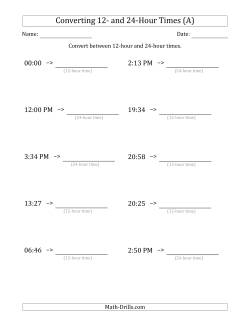
It is a very useful skill to be able to convert between 12 and 24 hour time in a global world. Even in places, like the U.S., where 12 hour time is used a lot, students still see time formatted in 24 hour time in a wide variety of situations.
Converting between time units worksheets are useful to test students understanding of time measurement and to give them more practice.
Elapsed Time Worksheets

Elapsed time refers to the amount of time that has passed between a start time and a finish time. This can be challenging to students if they are not completely familiar with the base 60 system used for second, minutes and hours, and the fact that there are 24 hours a day sometimes split into morning and afternoon times.
-
Elapsed Time with 1 Minute Intervals; Max 5 Hours Elapsed Time with 5 Minute Intervals; Max 5 Hours Elapsed Time with 15 Minute Intervals; Max 5 Hours Elapsed Time with 1 Minute Intervals; Max 24 Hours Elapsed Time with 5 Minute Intervals; Max 24 Hours Elapsed Time with 15 Minute Intervals; Max 24 Hours
-
Elapsed Time with 1 Minute/Second Intervals; Max 5 Hours Elapsed Time with 5 Minute/Second Intervals; Max 5 Hours Elapsed Time with 15 Minute/Second Intervals; Max 5 Hours Elapsed Time with 1 Minute/Second Intervals; Max 24 Hours Elapsed Time with 5 Minute/Second Intervals; Max 24 Hours Elapsed Time with 15 Minute/Second Intervals; Max 24 Hours
The elapsed date worksheets in this section are based on a three column table with ten rows. Each different version of the elapsed date table will challenge students in different ways. The worksheets that ask students to find the end date are given a start date and an elapsed time. These worksheets work well for starting at a specific point and counting up. The worksheets that ask students to find the start date, elapsed time or the end date will have random blanks in the table, so students may have to figure out the elapsed time forwards or backwards. Below you will find various challenges including elapsed time with days only, then we progressively add weeks, months, and years to the worksheets.
Please note that when finding future dates, it is important to start with the largest unit first and progress to the smaller units. For example, if the start date is February 8, 2020 and the elapsed time is 3 years, 2 months, 3 weeks and 6 days, you would add the three years first to get February 8, 2023. Next, add the months to get April 8, 2023. Finally, add the weeks and days to get May 5, 2023. You can add the weeks and days together as they are both exact lengths whereas years and months vary in size.
Adding and Subtracting Time
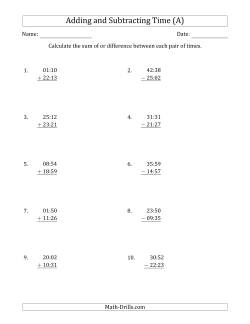
Adding and subtracting time is similar to adding any numbers, but the regrouping amounts are different. If you think of the decimal system, numbers are divided into places named: ones, tens, hundreds, etc. In time values, the places have different values based on an ancient Babylonian numbering system with a base of 60. In the "seconds place," there are 60 unique seconds from 0 to 59. The same is true for the "minutes place." The "hours place" can vary from 24 if one is interested in counting days as well, or can be greater than 24 if the largest place value is in the hours place. In these worksheets, students are challenged to regroup seconds and minutes as they add or subtract two time amounts.
-
Adding Hours, Minutes and Seconds (Compact Format) Adding Hours, Minutes and Seconds (Long Format) Subtracting Hours, Minutes and Seconds (Compact Format) Subtracting Hours, Minutes and Seconds (Long Format) Adding and Subtracting Hours, Minutes and Seconds (Compact Format) Adding and Subtracting Hours, Minutes and Seconds (Long Format)
